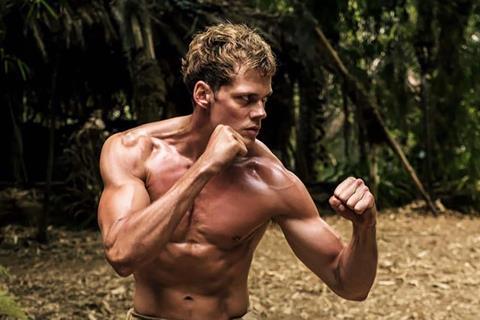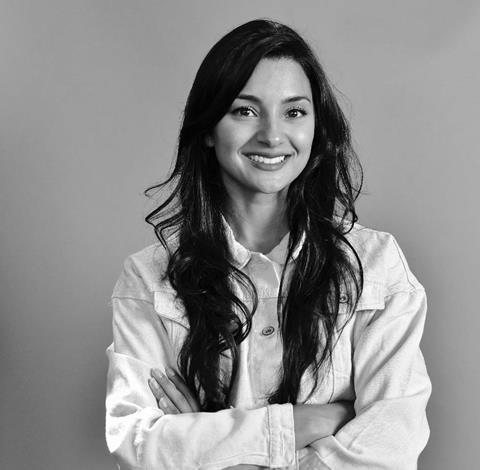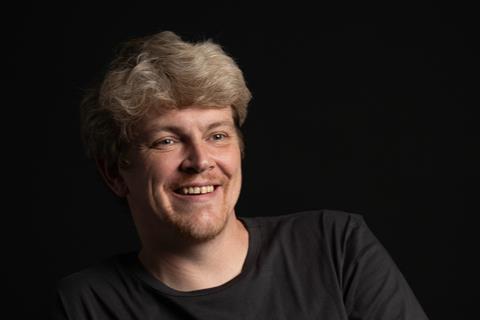
“I have always loved the goofy stuff, and the fun stuff, and the weird stuff,” says German director Moritz Mohr. “I enjoy Scorsese as much as the next guy, but I don’t want to be ‘the next Scorsese’. I just wanted to make something crazy and fun.”
A former video store worker, UCLA graduate and commercials director, the Berlin-based fun-seeker was inspired as a boy by John Woo’s 1986 action opera A Better Tomorrow, thrilled by the excess of Takashi Miike’s blood-drenched output, and besotted by the slapstick horror of Sam Raimi’s Evil Dead trilogy. Only in his wildest dreams did he imagine making a movie with Raimi. Yet, that is exactly what happened.
In 2017, off the back of a snappy, violent proof-of-concept trailer he had spent a year and $20,000 making, Mohr found himself in a meeting with the Evil Dead creator at Raimi Productions to discuss developing what would become his debut feature Boy Kills World. “It was insane,” Mohr says of that first encounter, before running out of words and simply acting out his head exploding.
It is not hard to see why Boy Kills World would have appealed to Raimi. It is a hyper-violent revenge thriller that is also an irreverent, surreal and oddly sweet comedy, centred on a deaf-mute martial-artist killing machine known only as Boy (Bill Skarsgard), whose internal monologue is heard as an exuberant voiceover while he seeks retribution for the death of his family in a dystopian, jungle-choked city.
“Sam just fell in love with the character, and he fell in love with his journey and story of revenge,” says Zainab Azizi, president of production at Raimi Productions. “What was interesting to us about Moritz is how fresh and bold and original he is. We’re always looking for storytellers who fit that mould, because that’s exactly the kind of cinema we want to watch.”
Slow motion
However, it would take a torturous five years to move Boy Kills World from concept to completion. After a year of development at Raimi Productions, says Mohr, “we got booted from the first studio, who said it was too niche, too crazy”. (Neither he nor Azizi can “name names” as “it’s so sensitive right now”, they apologise.) “Then, we found another studio, which took another year,” the director continues, “but then Covid happened and they closed down.”

Around then, Azizi said to Raimi, “We have to make this independently.” They needed investors, she argued, “who believed in us. When you make a studio film, they have formulas. We love making films with studios, but I thought this film needed someone to go, ‘Okay, here’s a cheque — go crazy, have fun.’”
So Team Raimi called their agents at CAA, and with the guidance of CAA Media Finance — which is co-representing domestic rights with Capstone Global, also the international sales agent — found funding from Alex Lebovici of Hammerstone Studios. He in turn brought in financiers Simon Swart and Wayne Fitzjohn of Nthibah Pictures in South Africa. “And that’s where we shot the film,” says Azizi. “Originally, we sold this as an $8m film, and it went up quite a bit after that. That just shows you what amazing partners they all were. Even though Moritz was a first-time filmmaker, everybody was so invested in this and wanted to support it as much as possible.”
Of course, there remained the danger of ‘too many cooks’, what with Vertigo Entertainment also involved (via Raimi’s longtime producing partner Roy Lee, who had originally shared the Boy Kills World trailer with him), plus producers Stuart Manashil of Novo Entertainment and Dan Kagan.
“It was challenging with so many voices,” admits Azizi, “but everybody knew the type of film we were making and were on the same page.” Mohr adds that “everybody behaved and played nice. There were obviously discussions about creative stuff from time to time, but nothing that would throw us off like, ‘Oh, we need to repaint the set,’ or something. The film was made in the indie spirit of get the best product for the money, and don’t be a spoiled princess.”
With all of Cape Town’s studio space taken up by The Woman King and Netflix show One Piece, the production rented the Good Hope Centre exhibition hall and set up its own studio. Meanwhile, Mohr pulled together an impressive cast to fill out his eccentric dramatic personae, including Michelle Dockery, Sharlto Copley, Brett Gelman and Famke Janssen as members of the tyrannical family targeted by Boy; The Raid’s Yayan Ruhian as murky mentor-figure the Shaman; and Happy Death Day’s Jessica Rothe (replacing Samara Weaving, lost to a scheduling conflict) as helmet – wearing hit girl June 27.
Naturally, the key role was that of Boy himself. Played in the proof of concept by fight co-ordinator and action designer/director Dawid Szatarski, the role required an actor who could handle the exacting combat scenes without requiring too many cuts to a double, and also be expressive enough to mitigate Boy’s inability to speak.
In Swedish actor Skarsgard, Mohr was sure of the latter quality from films such as It and The Devil All The Time, but needed to be certain of the former. “We wanted someone who can actually throw a punch,” says Mohr. “Bill had an instant connection with the character and really wanted to do action. He said, ‘I’m ready to train, I can start tomorrow.’ So we did a test in Berlin, while he was shooting John Wick: Chapter 4. We shot a short clip, just trying to figure out how he moves and what we could do with him. Everybody was relieved after seeing that. He trained his ass off and delivered on the action part.”
World builders
The production, say Mohr and Azizi, was a tricky one. Even aside from the Covid restrictions and setbacks, they had to contend with night shoots, child actors (twins Nicholas and Cameron Crovetti portray the young Boy, while Quinn Copeland plays the ghost of his sister), building a world from scratch and crafting “unique and fresh” action sequences. Not to mention executing the device of their main character never speaking out loud, yet often having dialogues with his ghost sister via voiceover.
“We came up with the plan of putting a mic in their ears and having his pre-recorded voice playing for them to hear. But that was all bullshit,” Mohr laughs. “After five minutes we said, ‘All right, the first AD is now just reading the lines.’”

There were “a couple of times”, the director admits, when he wondered why, on top of everything else, he decided to complicate matters further by making Boy a deaf-mute. But he has no regrets. “I’m so grateful this happened,” he says, adding that he is looking forward to seeing how it is received after its debut in Toronto’s Midnight Madness strand. “I’ve never been to a festival outside of Europe, but if the mood and energy is just a percentage of what people have told me, I’m going to have a lot of fun there.”
During their journey together, Azizi and Mohr have discussed other film ideas. But their main goal, Azizi says, is to make a sequel to Boy Kills World. As Mohr notes, though, they have only just come out of their “Boy-shaped bubble,” and with the strikes persisting, it is difficult to focus on what may or may not be titled Girl Kills World.
“We’ll see,” he says. “First, let’s see just how people like Boy Kills World. I think that’s going to be exciting enough.” Exciting and goofy and fun and weird.







![The Brightest SunScreen[Courtesy HKIFF]](https://d1nslcd7m2225b.cloudfront.net/Pictures/274x183/3/5/0/1448350_thebrightestsunscreencourtesyhkiff_312678.jpg)

























No comments yet